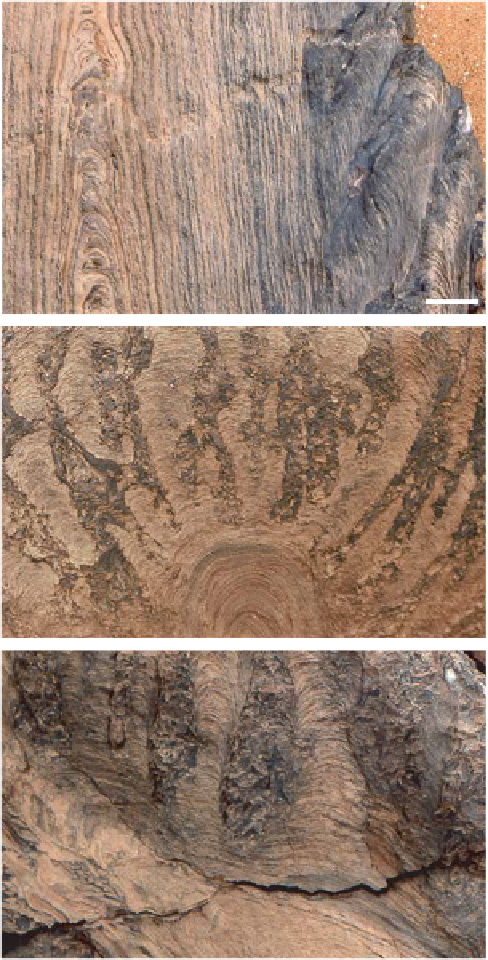Geology Reference
In-Depth Information
interstromatolitic breccia and carbonate
microspar. Interstromatolitic breccia consists of
variably convoluted, platy fragments (Fig. 9a-d)
that show distinct lamination and petrographic
fabric indistinguishable from that of intact
conical stromatolites. Clasts range in size from
1
(a)
25 mm and show variable degrees
of hydrodynamic sorting. Coarse-grained debris,
which shows the widest range of grain sizes and
poor to moderate sorting, occurs exclusively in
association with
Conophyton
and
Jacutophyton
(Fig. 9a-d). Fine-grained debris shows the most
hydrodynamic sorting and is found in associa-
tion with all stromatolite types, although it is
most prevalent in its association with
Tilemsina
(Fig. 8a). Carbonate microspar is locally abundant
as an interstromatolitic element, forming discon-
tinuous, massive to weakly laminated, undulatory
beds a few millimetres to > 50 cm thick. In addi-
tion to discontinuous beds, detrital microsparitic
carbonate also occurs as later-stage, occasion-
ally geopetal fi ll in voids formed by platy breccia
(Fig. 9b and c).
The lateral distribution of interstromatolitic
material within the Atar Formation reefs is
extremely variable. Beds of detrital microsparitic
carbonate greater than 30 cm thick can envelop
several adjacent
Conophyton
, yet not extend
laterally for more than a few metres. Single
Conophyton
columns can also be enveloped by
detrital microsparitic carbonate at one side and
coarse-grained platy breccia at the other. The
vertical distribution of interstromatolitic facies
is equally as variable, with the margin of a single
1.5 m tall
Conophyton
contacting up to fi ve dis-
tinct layers of interstromatolitic fi ll.
3 mm to 7
2 cm
(b)
20 cm
(c)
10 cm
Marine cement
Fig. 7.
Development of branching elements on
Conophyton
.
(a) Detail of
Jacutophyton
sp.
showing branch initiation
along a single laminae horizon. (b) Divergent branching
columns of
Tilemsina
sp.
overgrowing modifi ed top of
Conophyton
sp.
(c) Upward growth of
Baicalia
sp
.
above
toppled
Conophyton
sp.
Atar Formation stromatolite reefs contain locally
abundant marine cement (up to 25% of interstro-
matolitic material). Marine cement forms multi-
layered isopachous rims within voids defi ned by
interstromatolitic debris (Fig. 9a-d) and, more
rarely, along stromatolite edges and the deposi-
tional substrate. These fi rst-generation cements
are composed entirely of herringbone carbonate.
Herringbone carbonate is an unusual carbon-
ate morphology consisting of elongate crystals
in which the
c
-axis rotates throughout growth,
from parallel to perpendicular to crystal elon-
gation (Sumner & Grotzinger, 1996a,b), which
results in a characteristic sweeping extinction
parallel to crystal elongation direction (Fig. 9e-g).
of isopachous carbonate cement followed by
deposition of detrital microsparitic carbonate
(Fig. 8d).
Interstromatolitic detrital carbonate
Two distinct forms of interstromatolitic debris
occur within the Atar Formation reefs:




